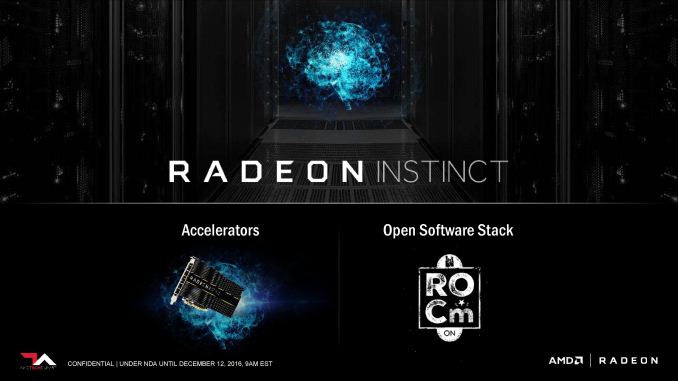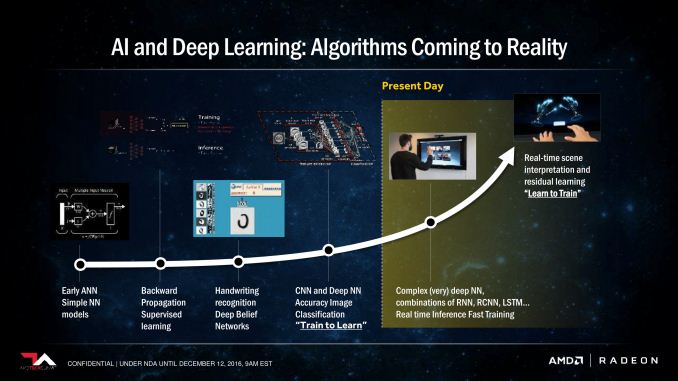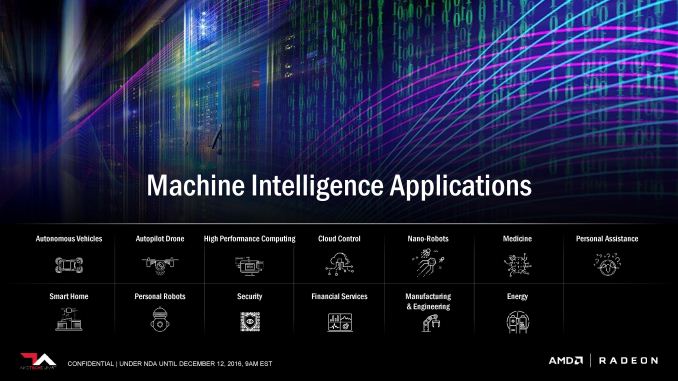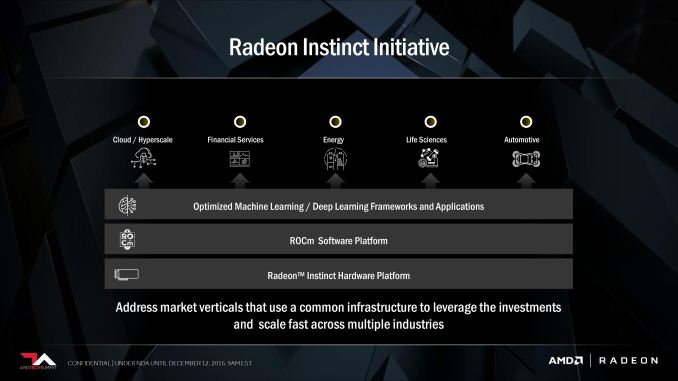AMD Announces Radeon Instinct: GPU Accelerators for Deep Learning, Coming In 2017
by Ryan Smith on December 12, 2016 9:00 AM EST- Posted in
- GPUs
- AMD
- Radeon
- Fiji
- Machine Learning
- Polaris
- Vega
- Neural Networks
- AMD Instinct

With the launch of their Polaris family of GPUs earlier this year, much of AMD’s public focus in this space has been on the consumer side of matters. However now with the consumer launch behind them, AMD’s attention has been freed to focus on what comes next for their GPU families both present and future, and that is on the high-performance computing market. To that end, today AMD is taking the wraps off of their latest combined hardware and software initiative for the server market: Radeon Instinct. Aimed directly at the young-but-quickly-growing deep learning/machine learning/neural networking market, AMD is looking to grab a significant piece of what is potentially a very large and profitable market for the GPU vendors.
Broadly speaking, while the market for HPC GPU products has been slower to evolve than first anticipated, it has at last started to arrive in the last couple of years. Early efforts to port neural networking models to GPUs combined with their significant year-after-year performance growth have not only created a viable GPU market for deep learning, but one that is rapidly growing as well. It’s not quite what anyone had in mind a decade ago when the earliest work with GPU computing began, but then rarely are the killer apps for new technologies immediately obvious.
At present time the market for deep learning is still young (and its uses somewhat poorly defined), but as the software around it matures, there is increasing consensus in the utility of being able to apply neural networks to analyze large amounts of data. Be it visual tasks like facial recognition in photos or speech recognition in videos, GPUs are finally making neural networks dense enough – and therefore powerful enough – to do meaningful work. Which is why major technology industry players from Google to Baidu are either investigating or making use of deep learning technologies, with many smaller players using it to address more mundane needs.
Getting to the meat of AMD’s announcement today then, deep learning has the potential to be a very profitable market for the GPU manufacturer, and as a result the company has put together a plan for the next year to break into that market. That plan is the Radeon Instinct initiative, a combination of hardware (Instinct) and an optimized software stack to serve the deep learning market. Rival NVIDIA is of course already heavily vested in the deep learning market – all but staking the Tesla P100 on it – and it has paid off handsomely for the company as their datacenter revenues have exploded.
As is too often the case for AMD, they approach the deep learning market as the outsider looking in. AMD has struggled for years in the HPC GPU market, and their fortunes have only very recently improved as the Radeon Open Compute Platform (ROCm) has started paying dividends in the last few months. The good news for AMD here is that by starting on ROCm in 2015, they’ve already laid a good part of the groundwork needed to tackle the deep learning market, and while reaching parity with NVIDIA in the wider HPC market is still some time off, the deep learning market is far newer, and NVIDIA is much less entrenched. If AMD plays their cards right and isn’t caught-off guard by NVIDIA, they believe they could capture a significant portion of the market within a generation.
(As an aside, this is the kind of quick, agile action that AMD hasn’t even been able to plan for in the past. If AMD is successful here, I think it will prove the value in creating the semi-autonomous Radeon Technologies Group under Raja Koduri).













39 Comments
View All Comments
Yojimbo - Monday, December 12, 2016 - link
Well AMD's biggest problem is the software stack. But that issue aside, only the MI25 looks promising to me. I'm not sure why we should be too confident in AMD's ability to get the ball rolling with machine learning when they've had HPC offerings all along and barely had success. Guess we gotta wait and see.Dribble - Tuesday, December 13, 2016 - link
The way AMD does best right now is bidding for custom hardware for specific customers, combined with their willingness to accept lower margins then the opposition, so they win the deal. They can then do something general purpose based off that and sell some more, but the core funding is done by the big customer. See console deals, or apple gpu deal for examples.Because that customer knows exactly what they want and AMD are so cheap the customer does most of the software, AMD just provides hardware. That I suspect will be the real aim here - provide google/amazon/someone big with some cheap custom hardware.
webdoctors - Tuesday, December 13, 2016 - link
Considering how the AMD ARM server initiative crashed and burned, I think this is going to be a pretty rough uphill battle. It seems the company has all the internal knowledge to create an end to end solution with their own CPU/GPU/motherboard/interconnect for HPCs, but somehow are drastically falling short against Intel and Nvidia whenever its time to execute.The prices are going to have to be very competitive to get a foothold into this market, but this is a market that's also not as price conscious as the consumer segment, when you consider bad software or tools can lead to man-months wasted (which is easily $10 of thousands of dollars when discussing Silicon valley engineering salary time).
Looks like 2017 should be interesting.
TheinsanegamerN - Tuesday, December 13, 2016 - link
It would help if they could deliver on time and on budget. They always seem to get products out months after they are supposed to.IntoGraphics - Wednesday, December 14, 2016 - link
That's typical of AMD.Here I have a Gigabyte RX 480 8GB. And they haven't even got drivers for other Linux distros than Ubuntu and RHEL. (I'm on Arch Linux.) The drivers they have for Ubuntu and RHEL are buggy, and there is no Vulkan support and spotty OpenCL support.
The Open Source drivers I'm using give me all kinds of artifacts and glitches in Blender as soon as its window is displayed. The Blender UI is constantly corrupted. I uninstalled.
And now they are already busy with other cards.
I'm also waiting for Zen to be released. To compare with what Intel has on offer. But it's highly unlikely that I'm going to stick into the meat grinder again.
It's probably never ever AMD again.
The current Linux driver situation is just unforgivable.
The green camp introduced GTX 1060 1 month after RX 480 and they have Linux drivers for all Linux distros. Same old. Same old.
IntoGraphics - Wednesday, December 14, 2016 - link
"I'm going to stick into the meat grinder again." should be "I'm not going to stick my d.ck in the meat grinder again.".appsforsys - Saturday, December 17, 2016 - link
Thank you for sharing your wonderful experience, I found it really very helpful and interesting.These tips are to be kept in mind for sure while writing.
Good one!
/
IntoGraphics - Tuesday, January 3, 2017 - link
I wish these incapable cu|\|ts would release stable, bug free and fast Linux drivers for Radeon RX for all Linux distros first. Motherfuckers, get your priorities right. Don't take money first and then ignore.IntoGraphics - Wednesday, January 4, 2017 - link
Radeon Itstinks.